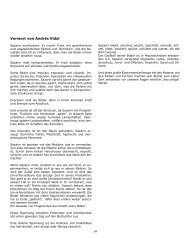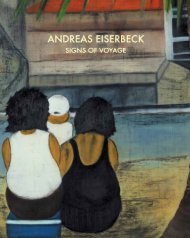DAVOOD ROOSTAEI and his creation Cryptorealism - Pashmin Art ...
DAVOOD ROOSTAEI and his creation Cryptorealism - Pashmin Art ...
DAVOOD ROOSTAEI and his creation Cryptorealism - Pashmin Art ...
Create successful ePaper yourself
Turn your PDF publications into a flip-book with our unique Google optimized e-Paper software.
<strong>DAVOOD</strong> <strong>ROOSTAEI</strong><br />
<strong>and</strong> <strong>his</strong> <strong>creation</strong> <strong>Cryptorealism</strong><br />
Prof. Dr. Phil. Cav. Hanns Theodor Flemming
Hanns Theodor Flemming <strong>and</strong> ...<br />
Prof. Dr. Phil. cav. Hanns Theodor Flemming,<br />
... Davvod Roostaei<br />
... Max Ernst<br />
... Friedrich Stowasser (Hundertwasser)<br />
... David Hockney<br />
... Joseph Beuys<br />
<strong>Art</strong> <strong>his</strong>torian <strong>and</strong> art critic, born in Hamburg, where he worked<br />
until <strong>his</strong> retirement. He studied art <strong>his</strong>tory, archeology <strong>and</strong> English<br />
at the Universities of Munich, Heidelberg, Hamburg, Oxford <strong>and</strong><br />
Berlin <strong>and</strong> did <strong>his</strong> Ph.D. with a dissertation on the English Pre-<br />
Raephaelite painter <strong>and</strong> poet Dante Gabriel Rossetti. In 1946 he<br />
became a freelance art critic for ”Die Welt” <strong>and</strong> permanent staff<br />
member of the ”Weltkunst” magazine, holding both positions for a<br />
great many years.<br />
University lecturer from 1959 until 1981, then professor of art <strong>his</strong>tory,<br />
specialising in design, at the Fachhochschule (technical college) in<br />
Hamburg. Numerous books, essays, broadcasts <strong>and</strong> lectures on 19th<br />
<strong>and</strong> 20th century painting <strong>and</strong> plastic arts.<br />
His most important work includes monographs on Ewald Matare,<br />
Henry Moore, Bernhard Heiliger, Gustav eitz, Friedrich Karl Gotsch,<br />
Rudolf Hausner, Arik Brauer <strong>and</strong> Bruno Bruni. Prof. Flemming<br />
numbers among the first interpreters of work by Bernhard Schulze,<br />
Horst Janssen <strong>and</strong> Paul Wunderlich. He was the discoverer of<br />
cryptorealism <strong>and</strong> its creator, Davood Roostaei.<br />
He visited Picasso, Matisse, Chagal, Nolde, Schmidt-Rottluff,<br />
Heckel, Max Beckmann, Oskar Kokoschka, Henry Moore, Salvador<br />
Dali, <strong>and</strong> had talks with Max Ernst, Marzel Duchamp, Otto Dix,<br />
Eduard Bargheer, Rudolf Hausner, Ernst Fuchs, Hundertwasser,<br />
David Hockney, Andy Warhol <strong>and</strong> Joseph Beuys, reported in both<br />
essays <strong>and</strong> lectures.<br />
In 1951 Prof. Flemming was made a membre societaire of the<br />
International Association of <strong>Art</strong> Critics, AICA, in Paris.<br />
In 1972, following <strong>his</strong> publications on Italian art, in particular on<br />
Giorgio de Chirico <strong>and</strong> the Pittura metafisica, he was awarded the<br />
title of ”Cavalire” by the Italian President.<br />
In 1998, he received the Austrian Cross of Honour, 1st Class, for<br />
Science <strong>and</strong> <strong>Art</strong>.<br />
Prof. Flemming died on the 5th August 2005 in Reinbek nr. Hamburg<br />
at the age of 89 years.<br />
18
<strong>DAVOOD</strong> <strong>ROOSTAEI</strong><br />
– <strong>and</strong> <strong>his</strong> <strong>creation</strong> <strong>Cryptorealism</strong><br />
Davood Roostaei is a painter of unusual intensity of expression – invariably<br />
filled with profound inspiration <strong>and</strong> that commitment to the cause of<br />
mankind which provides <strong>his</strong> work with a humane dimension, that has<br />
become rare in contemporary art. He is an artist committed to the human cause, to<br />
whom painting means life. He strives to convey to all people <strong>his</strong> message of fraternity <strong>and</strong><br />
tolerance, representing it passionately with all <strong>his</strong> strength, enforced by <strong>his</strong> own bitter<br />
experiences with an intolerant totalitarian regime. He is a universal artist who,<br />
metaphorically speaking, paints with the blood of <strong>his</strong> own heart. A challenging <strong>and</strong><br />
charismatic painter who has intuitively developed an individualistic painting concept.<br />
From the very beginning Davood Roostaei‘s works were characterised by unusual<br />
artistic skill, which he acquired during <strong>his</strong> studies at the Faculty of Fine <strong>Art</strong>s in<br />
Teheran <strong>and</strong> later in Cologne. T<strong>his</strong> continues to give him the groundwork for <strong>his</strong> artistic<br />
virtuosity <strong>and</strong> multifarious means of pictorial expression. in which Oriental <strong>and</strong> Occidental<br />
components combine in a dynamic fashion. Yet, above all, he acquired <strong>his</strong> abilities as a<br />
painter <strong>and</strong> graphic <strong>and</strong> fresco artist through autodidactic studies of the old masters <strong>and</strong><br />
the art of past centuries. Thus he gained essential insight into the creative works of both the<br />
Orient <strong>and</strong> the Occident. Only after the intensive study of artistic styles of the past <strong>and</strong><br />
their intrinsic expressions of craftsmanship <strong>and</strong> formation, did he begin to go <strong>his</strong> own<br />
way, which will be discussed in t<strong>his</strong> first monograph.<br />
As related in <strong>his</strong> personal accounts, mentioned elsewhere in t<strong>his</strong> monograph, Davood<br />
Roostaei has been doing creative work since early childhood. In the exquisite garden of<br />
<strong>his</strong> Persian childhood he had many opportunities to watch the wonders of nature <strong>and</strong> to<br />
create small works of art. Davood Roostaei descends from a royal family of the south of<br />
Persia; <strong>his</strong> great-gr<strong>and</strong>father having been a courageous king. His ancestors held leading<br />
positions up until the end of the Qajar rule. After the Qajar dynasty had been divested of<br />
power, the family estates were confiscated <strong>and</strong> its members imprisoned or killed.<br />
Davood Roostaei grew up in the south of Persia where he attended high school <strong>and</strong><br />
completed <strong>his</strong> university studies. His parents, who afforded him t<strong>his</strong> very modern<br />
education, are, sadly, not able to participate in <strong>his</strong> success. His father, who died young, was<br />
a respected surgeon whose favourite hobby was painting. Because Davood Roostaei<br />
objected to war <strong>and</strong> killing <strong>and</strong> refused to do military service during the war between<br />
Iran <strong>and</strong> Iraq, he was imprisonded for 2 years. Then he to came to Germany where<br />
he continued <strong>his</strong> artistic work with tremendous energy, first in Cologne <strong>and</strong> later in<br />
20
The artist before one<br />
of <strong>his</strong> ceiling paintings<br />
in the Villa Höltigbaum<br />
(on pages 43, 44)<br />
”Allegory”<br />
a painting which Davood Roostaei created in the<br />
Villa Höltigbaum based on <strong>his</strong>torical examples<br />
(on page 46)<br />
”Tangle-Haired Peter” – fresco painted<br />
by Davood Roostaei in the Villa Höltigbaum<br />
(on page 48)<br />
Restored picture in the Villa Höltigbaum<br />
(on page 49)
”First Love in Germany”<br />
40 x 60 cm.<br />
watercolours<br />
in a private collection<br />
At the centre of the picture is a portrait of Davood Roostaei’s unrequited<br />
first love in Germany. Behind t<strong>his</strong> the artist has painted himself in ashen<br />
grey shades depicting the grief he feels at parting. The girl smiles, however,<br />
for her heart does not feel t<strong>his</strong> grief, <strong>and</strong> she thinks of more material things.<br />
The wings indicate that the girl has no feeling of guilt. She rides into the<br />
distance on a white horse without giving a thought to Davood Roostaei’s<br />
sadness. The warm colours in which the background to the horse are painted<br />
represent happiness in contrast to the grey of gloom which surrounds<br />
Davood Roostaei. The five-German-Mark coin represents the girl’s fondness<br />
for material things <strong>and</strong> also Beethoven’s Fifth Symphony which expresses<br />
the fact that despite all the chaos, in the end light <strong>and</strong> hope will prevail.<br />
Beethoven st<strong>and</strong>s for constancy <strong>and</strong> the eternal, <strong>and</strong> t<strong>his</strong> is emphasised by<br />
the colour green in which he is portrayed.<br />
”Mirror in a Mirror”<br />
28 x 36 cm.<br />
watercolours<br />
in a private collection<br />
86
”Imprisoned in her own Beauty”<br />
60 x 80 cm.<br />
oil on canvas<br />
in a private collection<br />
In t<strong>his</strong> painting the artist attempts to come to terms with an unhappy<br />
relationship with a young woman, a well-known German model, who<br />
led him to believe that she loved him. The beautiful long blonde hair, like<br />
golden water, was one of her most spectacular features. But it was just her<br />
extraordinary beauty that kept her imprisoned in egoism. As a symbol of<br />
t<strong>his</strong> the beautiful l<strong>and</strong>scape at the centre of the painting is so near, but<br />
cannot be reached for it is obstructed by bars.
“The Resurrection of Prometheus“<br />
70 x 90 cm.<br />
oil <strong>and</strong> acrylic on canvas<br />
in a private collection<br />
Numerous artists have painted their version<br />
of the bound Prometheus. He has also been<br />
presented in chains in stage productions. Davood<br />
Roostaei’s Prometheus does not want to remain<br />
bound. He is a revolutionary who breaks <strong>his</strong><br />
chains; he wants to experience a new day, a new<br />
life.<br />
150
“Zeus“<br />
140 x 100 cm.<br />
oil <strong>and</strong> acrylic on canvas<br />
in a private collection







